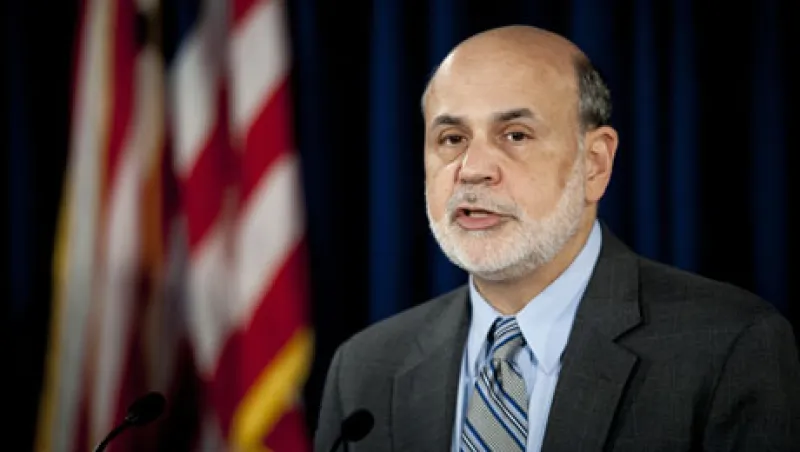If this was Janet Yellen’s housewarming gift, it should make for a rocky first few months in the new house.
Ben Bernanke has made open, transparent messaging a hallmark of his chairmanship of the Federal Reserve Board. So when the central bank’s policymaking Federal Open Market Committee decided not to begin scaling back its massive bond purchases at Wednesday’s meeting, markets were stunned. Investors had prepared themselves for a September start to the taper ever since May, when Bernanke first suggested that the Fed was getting closer to winding down the bond-buying program. But the FOMC injected fresh uncertainty into markets, saying in its statement that it would delay adjusting the pace of purchases until more evidence emerged that the economic recovery “will be sustained.” Ironically, Bernanke said market reaction to his earlier talk had caused the committee to change tack. “The committee has some concern that the rapid tightening of financial conditions in recent months could have the effect of slowing growth, a concern that would be exacerbated if conditions tightened further,” he told reporters after the meeting.
“The Fed’s decision turns on its head the entire consensus of the summer, namely that the U.S. is growing strongly, that rates must therefore increase, and the dollar will be stronger,” says Jan Dehn, head of research at Ashmore Group, a London-based emerging markets investment manager. “Clearly, the Fed’s ability to forecast one quarter ahead is seriously in need of improvement, because everything they believed in May seems to be null and void today, just a few months later.”
At his June press conference, Bernanke indicated the Fed was likely to start the taper in the autumn and finish its bond purchasing program in mid-2014, when the unemployment rate was expected to be about 7 percent, down from 7.3 percent today. On Wednesday, asked specifically whether that 7 percent market was still operative, he backed away from that signpost, refusing to commit to any specific unemployment indicator. He also acknowledged the possibility that the Fed might not even start to taper until 2014. The chairman’s shifting stance, coming after months of consistent and clear messaging, left analysts confused and the Fed’s credibility tarnished.
“The lack of any clear guidance on the criteria for tapering and the eventual ending of the asset purchase program means there is substantial uncertainty regarding the path of the asset purchase program,” wrote Dean Maki, chief U.S. economist at Barclays, in a client note following the announcement.
The impending transition at the top of the Fed, with Bernanke due to step down at the end of January, promises to add to the uncertainty. After former frontrunner Larry Summer withdrew his name from the succession race on Sunday, President Barack Obama is widely expected to nominate Yellen, Bernanke’s deputy and arguably the leading dove on the FOMC, to become the next chairman.
The bold and ambitious post-crisis experiment in unprecedented monetary easing has dominated Bernanke’s time at the helm of the Fed. Starting the taper would have begun to bring the curtain down on that era and enabled his successor to get off to a fresh start. Instead, the Fed’s activism now looks set to dominate the nominee’s Congressional confirmation hearings. The exit from QE, which always promised to be an exceptionally delicate task to manage, is bound to become more delicate still.
How markets will respond to this new uncertainty over the months ahead is difficult to gauge. “The market will not take Bernanke at face value as it did in May,” says Dehn. Given that the markets had already priced in the beginning of a QE taper, the Fed yesterday had “a free option to proceed without a major shock to the markets,” wrote Joseph LaVorgna, chief U.S. economist at Deutsche Bank, in a note following the announcement.
Much of the painful pricing in of the taper over the summer has now been undone. Markets rallied sharply in the wake of the FOMC announcement. The major U.S. equity indexes hit fresh highs, and the yield on U.S. 10-year Treasuries — which opened the day at 2.86 percent and had spiked earlier in the month to 2.98 percent — dropped to 2.69 percent. Emerging markets stocks and currencies soared.
The real question now is whether that jubilant reaction to the continuation of monetary stimulus will be sustained over the coming months, with investors returning to the wholesale search for yield that had marked much of the first half of this year, or whether the inevitability of the taper will prevent a frothy risk-on revival.
“The market has not become more rational overnight,” argues Dehn. The delay to the taper “will create excellent opportunities to add to emerging market positions. I hope market participants conclude from this that the recovery in the heavily indebted developed countries is extremely fragile, while EM — which was supposed to be in crisis, but clearly isn’t — is perfectly capable of living with higher rates.”
With the FOMC’s October meeting set to be overshadowed by the looming fight in Washington over the debt ceiling, most analysts, despite confusion over the pacing and guidance of the taper, still expect the Fed to begin winding back its bond purchases in December. Will investor sentiment turn sufficiently to make the beginning of the taper proper the same kind of shock that its initial signal was, earlier this year?
“Tapering was the right policy for one reason only — because printing money has created addiction to QE sugar highs to the point that the market sells off when we get stronger data because this leads to fears of ‘fewer’ drugs,” says Dehn. “In launching tapering, Bernanke was proposing a mild methadone treatment for the addiction. But he has shown that the FOMC has no stomach for the withdrawal symptoms, even when they are fully priced. It caved in, dispensing a fresh dose of hard drugs to the market. The next attempt to wean the market off the QE drug will be even more acrimonious. It is very much a wasted opportunity, because tapering was already fully discounted.”
Yesterday’s reversal was, he concludes, a “very big policy mistake.” The Fed may have momentarily revived investors’ appetite for risk, but the uncertainty that has roiled markets over the past four months is greater than ever.
Get the latest on banking.







